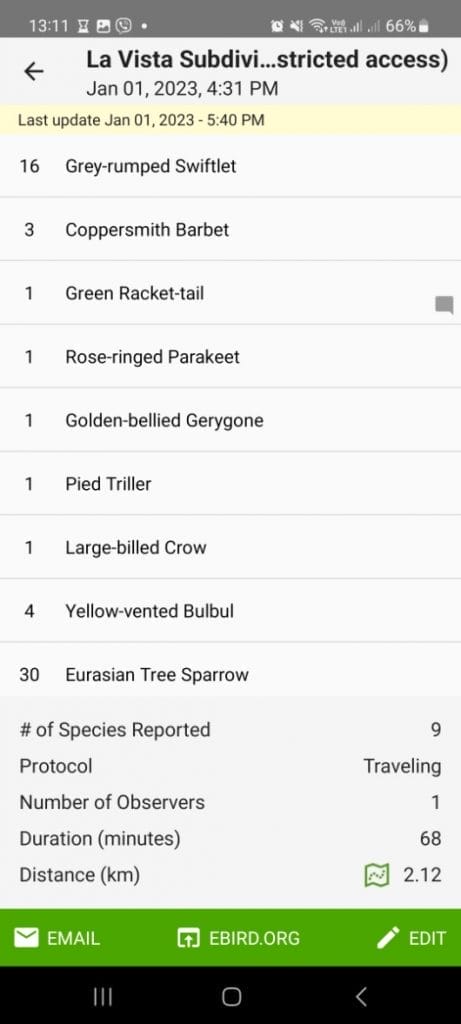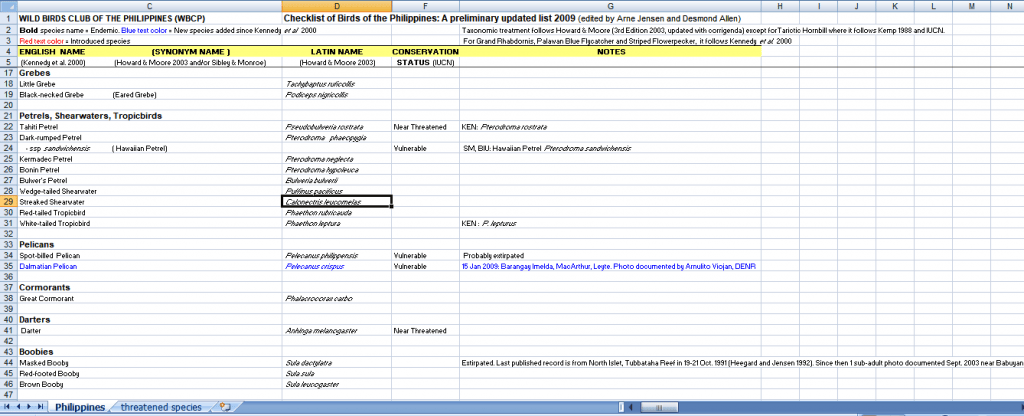By Tinggay R. Cinco and Jops Josef

The Wild Bird Club of the Philippines holds the most extensive database of bird records in the Philippines. The bird list serves as the very backbone of the club that gives recognition to its existence. The generated annual checklist is prepared and published by the WBCP’s Records Committee with accidental or rare sightings validated the Rarities Committee composed of experts in the field of ornithology. The published report in turn reflects the current birdlife in the country.

The process of coming up with the database is based mostly on the reports of bird sightings by WBCP members after a birdwatching trip. This procedure has been done since the days when the club started in 2003 led by one of its founding members, James McCarthy.
In the early days, reports where randomly posted in an e-group. As reports needed to be formalized, a system using an excel file was generated. Over the years these reported sightings were collated by the club members together with additional data from websites, blogs, social media, forums, bird guided tours and external emails from individuals.
The WBCP’s participation in the annual Asian Waterbird Census also became a vital source of data. All these bird data which included the number of species observed, distribution of species, range and the occurrence of accidental species were collated.
Rarities, country records and unusual sightings were validated paired with field notes, photographs, and observations prior to inclusion in the checklist.


The first formalized Checklist of Birds of the Philippines was first published in the WBCP’s website www.birdwatch.ph in 2009, with a total of 600 Philippine bird species. Prior to 2009, A Guide to Birds of Philippines by Robert S. Kennedy, et al, published by the Oxford University Press was used as reference for the listing and illustrations of the 572 bird species of the country.
Summary of the Annual WBCP Records Checklist
| Year | Total No. of Bird Species | Endemics | Migrants | Residents and Migrants(combined) |
| 2000 * A Guide to Birds of Philippines by Robert S. Kennedy | 572 | 172 | ||
| 2009 | 600 | 181 | 419 | |
| 2013 | 672 | 235 | 437 | |
| 2014 | 682 | 235 | 447 | |
| 2016 | 683 | 239 | 444 | |
| 2017 | 691 | 239 | 452 | |
| 2018 | 695 | 241 | 256 | 450 |
| 2019 | 700 | 241 | 261 | 450 |
| 2020 | 709 | 241 | 275 | 450 |
| 2021 | 714 | 255 | 278 | 452 |
| 2022 | 725 | 255 | 278 | 460 |
| 2023 | 735 | 258 | 288 | 462 |
During the course of time, the WBCP collaborated with eBird, the data gathering arm of the Laboratory of Ornithology from Cornell University in the United States. The joint effort led to the accelerated compilation of data gathering and the generation of the yearly Philippine bird checklist. The current use of eBird’s mobile application has contributed to the exponential increase in reports and data gathered.

Birdwatching and the reporting of bird sightings is a form of citizen science which empowers the non-scientific community to contribute data and information which may be useful to scientists, government, and non-government entities in policy decision making. The presence of birds is an indication of a sound environment. The loss or decline in populations may be indicative of habitat destruction or climate change. The annual Philippine bird list is the very statement of the country’s bird life. The data produced is the key to the conservation of these avian species surviving amidst the man-made challenges posed to the biodiversity upon various ecosystems. Quoting Arne Jensen, WBCP founding member, Records Committee Chair (2003-2022) “What is good for the birds is good for the people.”

To the admin,
Hello everyone, i learned that as of 2023 you identified 735 total birds species… Now, would you mind if i ask, out of that 735 birds how many families ad genus did you identified?
Thank you very much, and hoping for your response ahead.
Regards,
Afed